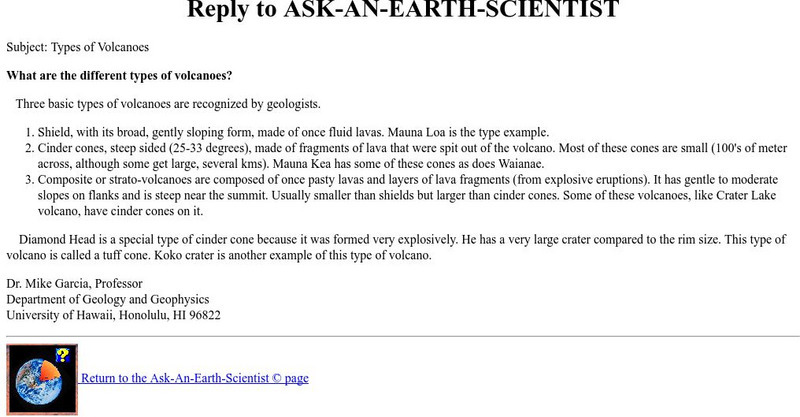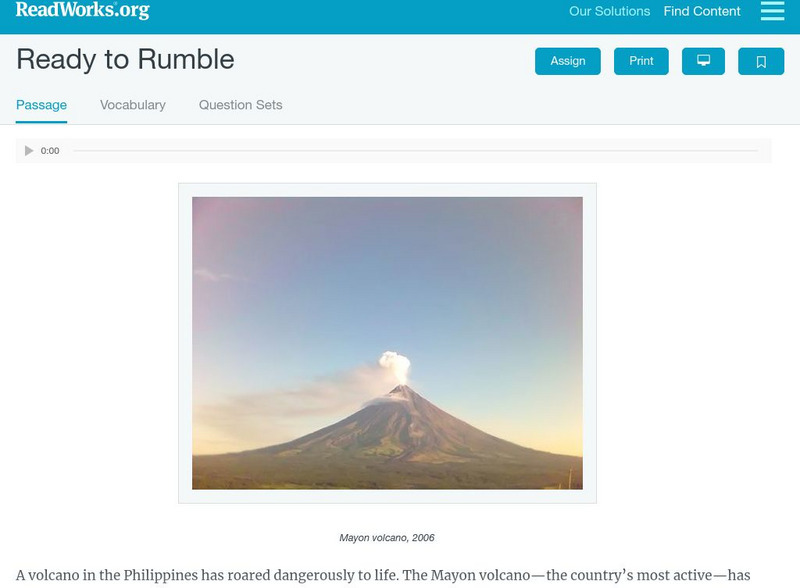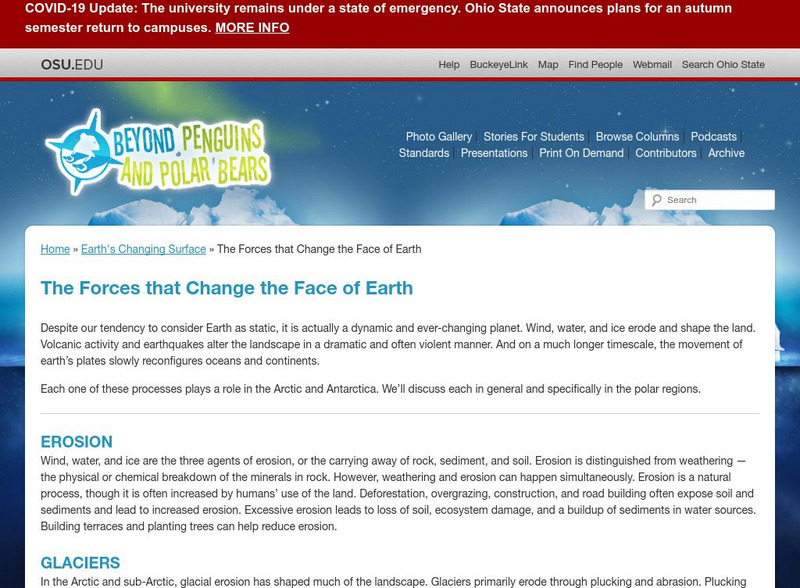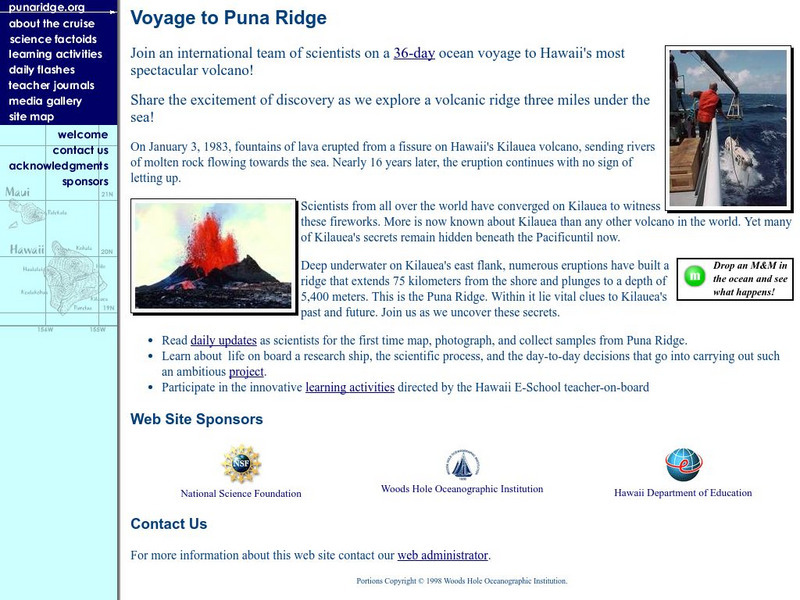Hi, what do you want to do?
Curated OER
Malia
Fourth graders begin their examination of the Hawaiian Islands. Using their island bookmarks from a previous activity, they work together to put the information into a book. They identify the physical and human characteristics of the...
Curated OER
How to Recycle a Rock
Third graders explore the rock cycle and explore how rocks are made, changed, destroyed and recreated. They create representations of these processes with hands-on activities.
Curated OER
Where Did It Come From?
Students research island formation, plot locations on a map and make an analysis of why some islands are formed where they are.
Curated OER
Hazards: Sixth Grade Lesson Plans and Activities
Sixth graders explore the damage associated with an earthquake by designing a structure that can withstand earthquake intensities on a shaker board. They then view tips for preparing for an earthquake, and what...
Curated OER
Building for the Big One
Students build and test structures that can best withstand earthquakes. They create their structures from playdough, cornstarch, grape-nuts and popsicle sticks and place their structures on a "shake table."
Curated OER
Graham Cracker Plate Tectonics
For this plate tectonics worksheet, students use Graham crackers, frosting, water and a paper plate to simulate tectonic processes such as convergent, divergent and transforming plate boundaries.
Curated OER
Where is Everyone Going?
Learners conduct an experiment. For this emergency response lesson, students watch videos about hurricanes and discuss the difference between natural disasters and man-made disasters. Learners perform a hurricane demonstration and...
Curated OER
Landforms - Landform Examples in the Philippines (Matching)
In this landforms instructional activity, students match the landforms to their definitions. Students complete 10 matches on this instructional activity and answer true and false and multiple choice questions about landforms in the...
Curated OER
Mapping the National Parks
Young scholars research national parks. In this science lesson, students view a video about the national parks and discuss the environments found within the national parks.
Curated OER
Science Quiz: Earth Quiz
For this earth science quiz worksheet, learners respond to 20 short answer and true or false questions regarding earth science topics.
Curated OER
Plate Tectonics
Students watch a video about plate tectonics. in this Earth Science lesson, students watch a video clip from Bill Nye about Continental Drift and Plate Tectonics. They make a slight crack in a hard boiled egg and manipulate the egg to...
Curated OER
Modifying an HTML Document
Students make changes in HTML documents by re-opening workspace for their web pages, using the text editor, and reloading document in web browser to see changes.
Merriam-Webster
Merriam Webster: Dictionary Illustration: Types of Volcanoes: Types of Volcanoes
A labeled diagram of three types of volcanoes: cinder cone, shield, and stratovolcano.
University of Hawai'i
Ask an Earth Expert: What Are the Different Types of Volcanoes?
A concise explanation of the three types of volcanoes recognized by geologists.
Read Works
Read Works: Ready to Rumble
[Free Registration/Login Required] Students read about three different types of volcanoes. A question sheet is available to help students build skills in classifying and categorizing.
Ohio State University
Beyond Penguins and Polar Bears: The Forces That Change the Face of Earth
Learn how different types of Earth processes change Earth's surface.
Climate Literacy
Clean: Mt. Pinatubo and the Atmosphere
This lesson explores the impact of volcanic eruptions on the atmosphere. Students will analyze three types of visual information: a graph of aerosol optical depth v. global temperature, a global map with temperature anomalies, and an ash...
PBS
Nova: Seismic Signals
Scientists have determined that the earthquakes preceding volcanic eruptions are different than those that precede earthquakes. Discover the sounds and wave patterns produced by the three different types of volcanic seismic activities.
Other
Puna Ridge: Voyage to Puna Ridge
On January 3, 1983, fountains of lava erupted from a fissure on Hawaii's Kilauea volcano, sending rivers of molten rock flowing towards the sea. Nearly 16 years later, the eruption continues with no sign of letting up. This site provides...
Science Education Resource Center at Carleton College
Serc: A Data Rich Exercise for Discovering Plate Boundary Processes
This article in the Journal of Geoscience Education describes a classroom exercise based on four world maps containing earthquake, volcano, topographical and seafloor age data. Students participate in this exercise by using a "jigsaw"...
Curated OER
Educational Technology Clearinghouse: Maps Etc: North America, 1868
A map from 1868 of North America, Central America, and the Caribbean showing the physical features of the region, vegetation types, ocean currents, temperatures, principal products and mineral deposits. Mountain chains are represented by...
Curated OER
Educational Technology Clearinghouse: Maps Etc: South America (Physical), 1868
A map from 1868 of South America showing the physical features of the region, vegetation types, ocean currents, temperatures, principal products and mineral deposits. Mountain chains are represented by lines of varying thickness, with...


























